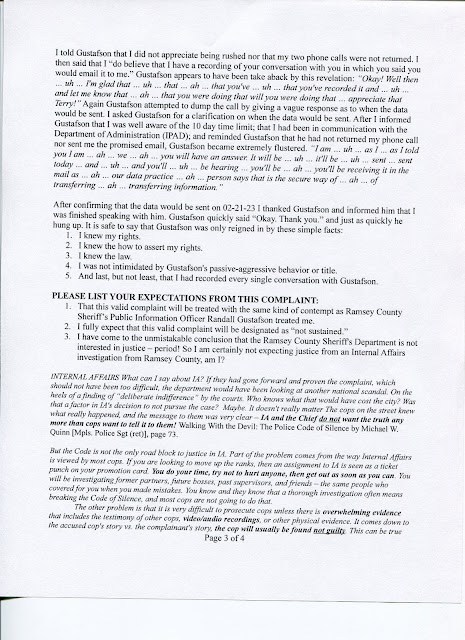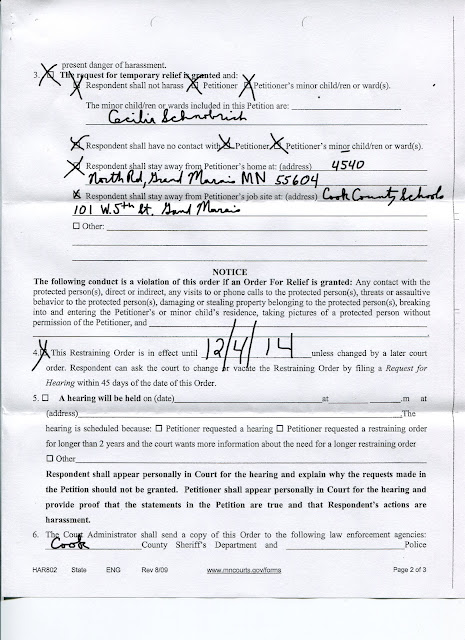Updated: 05-23-13
Updated: 02-28-13
Original Post
Lion News: Internal Affairs Complaint VS Ramsey Co.'s Randall Gustafson's Contemptuous Attitude?
Aggressiveness: The Tantrum Trap
… aggressive people are insistent on
standing up for their own rights while ignoring and violating the
rights of others.
Contacts: Communicating
Interpersonally, by Teri Kwal Gamble & Michael Gamble, page 351.
The dash cameras, for example, cost
$6,000 each, while the head cams are less than $2,000 apiece. The
cameras will cut down on officers working overtime to testify in
court because the video will speak for them in many cases. And there
will be a lot fewer personnel hours spent investigating complaints
from the public against officers. Body cameras: The new eyes of the
law, Article by: HERÓN MÁRQUEZ ESTRADA , Star Tribune, Updated:
December 8, 2010 - 8:47 AM.
But the Code is not the only road block
to justice in IA. Part of the problem comes from the way Internal
Affairs is viewed by most cops. If you are looking to move up the
ranks, then an assignment to IA is seen as a ticket punch on your
promotion card. You do your time, try not to hurt anyone, then get
out as soon as you can. You will be investigating former partners,
future bosses, past supervisors, and friends – the same people who
covered for you when you made mistakes. You know and they know that a
thorough investigation often means breaking the Code of Silence, and
most cops are not going to do that.
The other problem is that it is very
difficult to prosecute cops unless there is overwhelming evidence
that includes the testimony of other cops, video/audio recordings, or
other physical evidence. It comes down to the accused cop's story vs.
the complainant's story, the cop will usually be found not guilty.
This can be true even when there is physical evidence to support a
claim of misconduct. When the Code of Silence is invoked, the cops
stick together on their story, there is little hope of justice being
served. Walking With the Devil: The Police Code of Silence by Michael
W. Quinn [Mpls. Police Sgt (ret)], page 77-78.
Now, here's the interesting part.
Langer found that she could get almost everyone to agree to let
another person cut in front of them at the copy machine by adding one
detail to the request – a reason for why the machine was needed.
This makes sense. It takes a cold heart to deny someone, perhaps
panic-stricken with an urgent need, the simple use of a copy machine.
The odd thing about Langer's study is that although some of the
reasons made no sense at all, nearly everyone let the person cut in.
For example, on some occasions Langer's collaborators would say
“Excuse me: May I use the Xerox machine, because I have to make
copies.” When you think about it this is a pretty silly thing to
say: Why would you need a copy machine if you were not planning to
make copies? It is the same as no reason at all. But that is the
point. Most people in the study did not think about it and mindlessly
complied with the request. Any reason will do! Pratkanis, Anthony and
Aronson, Elliot.“Age of Propaganda": The Everyday Use and
Abuse of Persuasion” (New York: 2001) Page 34.
INTERNAL AFFAIRS What can I say about
IA? If they had gone forward and proven the complaint, which should
not have been too difficult, the department would have been looking
at another national scandal. On the heels of a finding of “deliberate
indifference” by the courts. Who knows what that would have cost
the city? Was that a factor in IA's decision to not pursue the case?
Maybe. It doesn't really matter The cops on the street knew what
really happened, and the message to them was very clear – IA and
the Chief do not want the truth any more than cops want to tell it to
them! Walking With the Devil: The Police Code of Silence by Michael
W. Quinn [Mpls. Police Sgt (ret)], page 73.
Behold, I send you forth as sheep in
the midst of wolves: be ye therefore wise as serpents, and harmless
as doves. Matthew 10:16 (King James Version)




























































